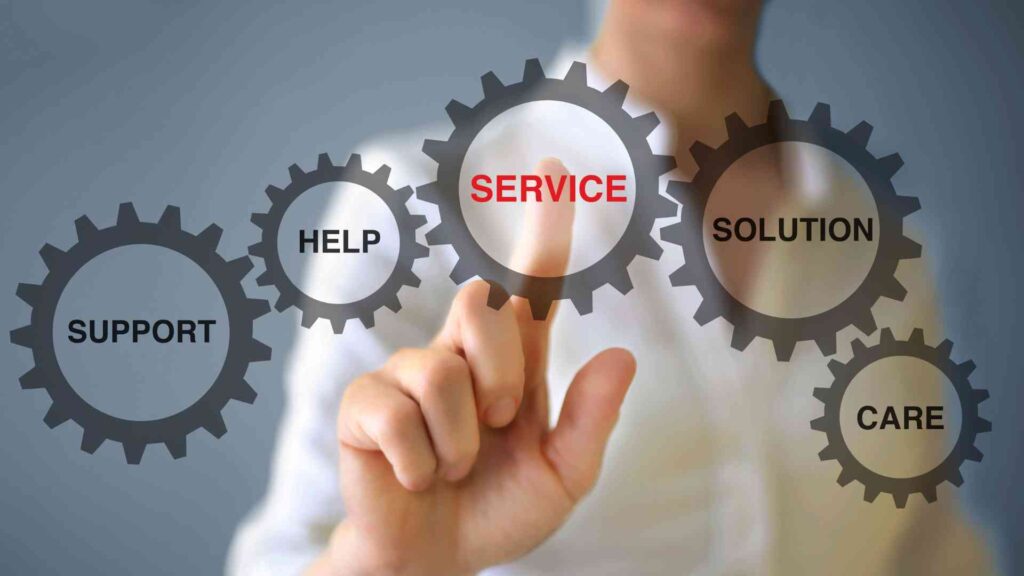The pace of technology advancement is at a record high. This rapid evolution, combined with the digital transformation wave, is reshaping the IT services landscape.
As we gradually start 2024, several trends stand out that will redefine the future of IT services. This article aims to highlight these key IT service trends to look out for in 2024 and discuss their potential impacts.

Understanding IT Services
Definition of IT Services
IT services play a crucial role in the modern business landscape, offering the backbone for companies to operate efficiently and effectively in a digital world. These services cover a broad spectrum, including but not limited to, network management, software development, cybersecurity, data analytics, and cloud computing.
The goal of IT services is to ensure that an organization’s technology infrastructure is always running smoothly, securely, and in alignment with its business objectives. By leveraging IT services, businesses can improve their operational efficiency, enhance their ability to innovate, and gain a competitive edge in their industry.

Moreover, the evolution of IT services has been significantly influenced by advancements in technology, such as artificial intelligence (AI), machine learning, and blockchain.
These technologies are not only transforming the way IT services are delivered but also how they are consumed by businesses.
For instance, AI and machine learning algorithms are now being integrated into IT service management tools to automate routine tasks, predict potential system failures, and provide actionable insights to decision-makers.
As a result, organizations can anticipate and mitigate issues before they impact operations. Leading to reduced downtime and improved service quality.
In essence, IT services are becoming more proactive, intelligent, and aligned with the strategic goals of an organization. Thereby playing a pivotal role in driving digital transformation.
Importance of IT Services
In the context of enterprise operations, IT services are particularly vital. They facilitate the seamless integration of technology into various business processes. Enabling companies to scale, adapt to market changes, and meet the evolving needs of their customers.
Enterprises rely on comprehensive IT services to manage vast amounts of data, ensure cybersecurity, support remote work environments, and maintain critical infrastructure.
This reliance underscores the strategic role of IT services in not only sustaining day-to-day operations. But also in paving the way for innovation and expansion.
For an enterprise, effective IT service management can lead to streamlined workflows, enhanced security, and improved decision-making capabilities. All of which are crucial for maintaining a competitive edge in today’s fast-paced business environment.
Moreover, the advent of cloud computing, big data analytics, and AI has elevated the importance of IT services in enterprises to new heights.
These technologies offer enterprises the tools to unlock valuable insights from their data, automate complex processes, and deliver personalized customer experiences.

However, harnessing these technologies requires a robust IT service framework that can handle the complexity of deploying, managing, and securing these solutions.
Consequently, enterprises are increasingly investing in IT services that not only keep their systems running efficiently. But also enable them to leverage emerging technologies to drive business growth.
In essence, IT services are becoming a strategic asset for enterprises, integral to achieving operational excellence and fostering innovation.
The Evolution of IT Services
Recent IT Service Trends
The recent trends in IT services revolve around digital transformation, which includes cloud computing, big data, and cybersecurity. These trends have been instrumental in reshaping the IT service industry, leading to more efficient and secure business operations.
Artificial Intelligence and Machine Learning
As we move further into 2024, the impact of Artificial Intelligence (AI) and Machine Learning (ML) on IT services is becoming increasingly profound.
These technologies are set to redefine the paradigms of automation, prediction, and personalization within IT service management. Offering unprecedented efficiencies and capabilities.
AI and ML are not just automating routine tasks; they are enabling predictive maintenance of IT infrastructure, foreseeing issues before they escalate into significant problems. Thereby ensuring uninterrupted business operations.
Furthermore, they facilitate the personalization of IT services. Tailoring support and solutions to the unique needs of each user or business function.
This level of sophistication in IT services will not only enhance operational efficiency but also significantly improve user satisfaction and engagement. Marking a pivotal shift in how technology services support business objectives in the digital age.
Looking to implement an AI solution into your daily operations ? Book a meeting with us and let us guide you through with our expertise
Cloud Computing and Services
As cloud computing continues to shape the IT landscape in 2024, five key developments stand out for their significant impact on businesses and technology strategies:
- Hybrid and Multi-Cloud Strategies: Organizations are increasingly adopting hybrid and multi-cloud environments to leverage the strengths of different cloud services while enhancing flexibility, business continuity, and compliance. This approach allows for a more resilient and optimized IT infrastructure that can adapt to varying workload requirements.
- AI and Machine Learning Enhancements: Cloud platforms are integrating advanced AI and machine learning capabilities. Enabling businesses to deploy complex analytics, automate processes, and derive insights with ease. This democratization of AI technologies fosters innovation across sectors by making cutting-edge tools more accessible.
- Sustainability and Green Computing: The emphasis on environmental sustainability is pushing cloud providers to use renewable energy sources and improve data center energy efficiency. This focus helps reduce the carbon footprint of IT operations and supports organizations’ sustainability objectives.
- Enhanced Security and Compliance Measures: In response to evolving cybersecurity threats, cloud providers are bolstering their services with advanced security features. Such as automated threat detection, encryption, and zero trust architectures. Robust compliance frameworks are also being implemented to help businesses adhere to regulatory standards across industries and regions.
- Serverless Computing: Gaining popularity for its ability to eliminate infrastructure management tasks, serverless computing allows developers to run applications without concerning themselves with the underlying servers. This model reduces operational costs and enables developers to focus more on innovation rather than infrastructure maintenance.
These trends underscore the evolving nature of cloud computing. Highlighting its critical role in driving efficiency, innovation, and sustainability in the digital era.
As businesses continue to navigate the complexities of the digital landscape, these developments offer strategic pathways to harness the full potential of cloud technologies.
A quick look at Cloud computing in this video :
Cybersecurity Measures
In 2024, the accelerated pace of technology adoption across various sectors has underscored the critical importance of cybersecurity.
As businesses and individuals alike become more dependent on digital platforms for everything from commerce to communication, the potential attack surface for cyber threats expands significantly.
This scenario necessitates a proactive approach from IT service providers, who must prioritize advanced threat detection and mitigation techniques.
The role of cybersecurity is evolving from a defensive perimeter to an integral component of every technology adoption strategy. Ensuring that as new technologies are embraced, their potential vulnerabilities are addressed from the outset.
This shift is driving a more resilient digital infrastructure. Where security considerations are embedded in the design phase, rather than being an afterthought.
Moreover, cybersecurity measures are set to play a significant role in the trust and reliability of digital services.
With the increasing sophistication of cyber threats, including ransomware, phishing, and state-sponsored attacks, the demand for innovative cybersecurity solutions is at an all-time high.
Technologies such as artificial intelligence (AI), machine learning (ML), and blockchain are being leveraged to enhance threat intelligence, real-time monitoring, and secure transactions, respectively.
The integration of these technologies into cybersecurity strategies not only improves the detection and response rates. But also helps in predicting and preventing potential breaches before they occur.
As technology adoption continues to grow, the significance of cybersecurity in safeguarding digital assets and maintaining user confidence cannot be overstated. Making it a cornerstone of the digital era.
Internet of Things (IoT)
The Internet of Things (IoT) is revolutionizing the landscape of IT services by enhancing productivity and simplifying deployment processes.
By connecting a vast array of devices and systems, IoT technology enables the automated collection and exchange of data, facilitating remote monitoring and control.
This interconnectivity allows for more efficient use of resources. Reducing manual labor and improving overall operational efficiency.
As IoT devices become more prevalent, the deployment of IT solutions can be streamlined. Allowing for rapid scaling and customization to meet specific needs.
The integration of IoT technology thus holds the promise of significantly boosting productivity. As it enables real-time decision-making and predictive maintenance, minimizing downtime and optimizing system performance.
The evolution of IoT is not just reshaping IT services. It’s setting a new standard for how technology can enhance business processes and outcomes.
Dive deeper into the subject through this article.
Big Data and Analytics
Big data and analytics, fueled by advancements in AI tools and quantum computing, are at the forefront of transforming business operations. As we move into 2024, the capability to analyze vast datasets has become more critical than ever. Enabling businesses to derive actionable insights and make informed decisions swiftly.
Quantum computing, with its potential to process complex data at unprecedented speeds, is set to revolutionize analytics by significantly reducing the time required for data analysis.
This, combined with AI tools that leverage algorithms and machine learning, allows for the automation of data processing and interpretation. Making analytics more efficient and accurate.

Moreover, natural language processing (NLP), a subset of AI, is enhancing the way businesses interact with their data.
NLP enables machines to understand human language. Allowing for more intuitive querying of databases and the analysis of unstructured data, such as customer feedback and social media conversations.
This integration of quantum computing, AI tools, and NLP is not just streamlining data analysis processes. But is also providing deeper insights that were previously unattainable.
As a result, businesses can anticipate trends, optimize operations, and tailor their strategies to meet the increasingly dynamic market demands. Thus gaining a competitive edge in their respective industries.
The Impact of these Trends
On Businesses
The evolving technology trends in 2024, promise to revolutionize businesses. By enhancing operational efficiency, reducing costs, and sharpening decision-making.
These innovations automate processes, optimize resource use, and provide deep insights from big data. Driving strategic growth and competitive advantage in the digital age.
On IT Professionals
For IT professionals, the shifting landscape of IT services necessitates a change in focus. Placing a top priority on upskilling to remain competitive and effective in their roles.
Particularly, the integration of DevOps practices into the development and deployment of software is a clear example of this evolution.
DevOps, which emphasizes collaboration, automation, continuous integration, and continuous delivery, is becoming increasingly critical for organizations looking to streamline their IT operations and enhance efficiency.
As IT services evolve, professionals must adapt by acquiring new skills in areas such as cloud computing, cybersecurity, and data analytics. While also embracing the culture and methodologies of DevOps.
This comprehensive approach not only ensures that IT professionals can manage and deploy systems more effectively. But also positions them to lead and innovate in an environment where technology adoption is accelerating.
By prioritizing these skillsets, IT professionals can ensure they remain invaluable assets in the dynamic world of IT services.
On End-users
As technology trends continue to evolve, end-users will benefit from enhanced services that offer seamless interactions and tailored experiences.
Innovations in generative AI, big data, and IoT will enable more intuitive and responsive services. Transforming how users engage with digital platforms and ensuring that their needs are met with unprecedented precision and efficiency.
Preparing for the Future of IT Services
Upskilling for New Technologies
The rapid pace of IT development calls for continuous learning. IT professionals must upskill to stay relevant in the industry.
Investing in Future Tech
Businesses need to invest in future technology to stay competitive. This includes adopting AI, ML, IoT, and other emerging IT trends.
- AI for Customer Service: Tools like Intercom, Vitaminai and Drift provide AI-powered chatbots that can automate customer interactions, offering immediate responses and support 24/7.
- Machine Learning for Data Analysis: TensorFlow and Scikit-learn are popular ML libraries that enable businesses to analyze data and build predictive models for insights and decision-making.
- IoT Devices for Operational Efficiency: Platforms like Cisco IoT and GE Predix support the integration of IoT devices into business operations, enabling real-time monitoring and management of assets.
- Blockchain for Security and Transparency: Ethereum and Hyperledger Fabric are platforms that facilitate the creation of blockchain applications for secure and transparent transactions.
- Cloud Computing for Scalability: Amazon Web Services (AWS), Microsoft Azure, and Google Cloud Platform offer scalable cloud services for storage, computing, and networking needs.
- Quantum Computing for Complex Problem-Solving: IBM Quantum Experience and D-Wave Systems provide access to quantum computing resources, allowing businesses to explore solutions for complex problems.
- AR and VR for Training and Marketing: Unity and Unreal Engine are powerful platforms for developing AR and VR applications, used for immersive training programs and innovative marketing strategies.
Conclusion
As we look forward to 2024, the IT service industry’s future is exciting and promising. The trends discussed in this article will shape the technology landscape, offering a multitude of opportunities for businesses, IT professionals, and end-users.
It’s essential to keep an eye on these trends and prepare for the future of IT services.
You are looking to implement these IT features in your business? Get in touch with us.
